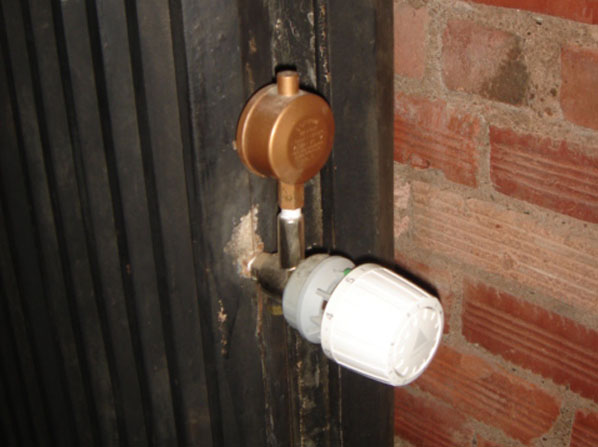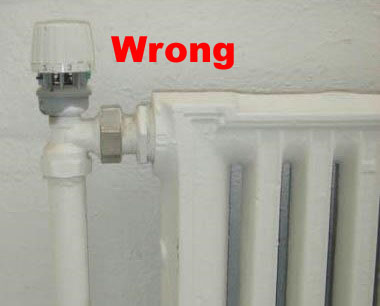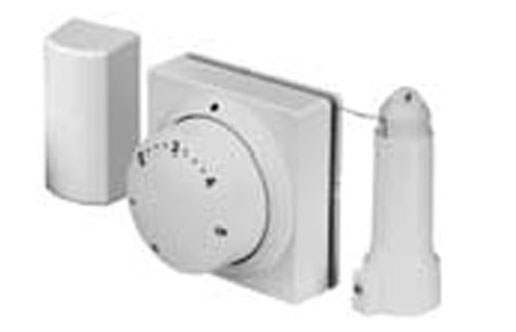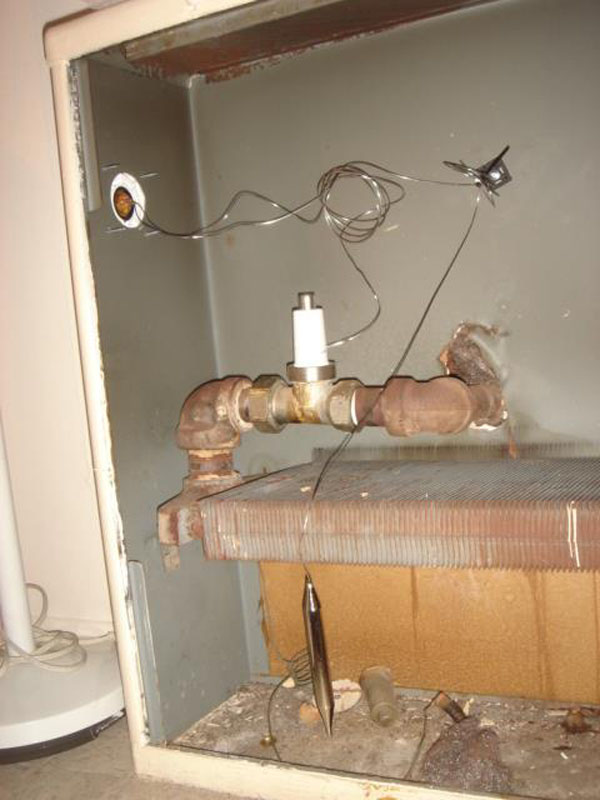Installing Thermostatic Radiator Valves
In steam-heated buildings, some apartments can overheat even after the balancing work has been completed. Thermostatic Radiator Valves (TRVs) can prevent this, allowing tenants to control their own heat. But first the heating system has to be set up correctly, or the TRVs won’t work.
(Note: Sometimes TRVs are called “Danfoss valves,” but several firms make them.)
Complete the System Work
One-Pipe TRVs Require Low-Pressure Operation
When one-pipe TRVs work, they work very well. But they often don’t work. The problem seems to be excessive steam pressure. The lower the steam pressure, the better one-pipe TRV’s work. In fact, one manufacturer states that their one-pipe TRVs won’t work above 1½ PSI.
This makes sense when you think about how a one-pipe TRV operates: it doesn't close off the steam supply. Instead, it relies on air-binding to block steam from entering the radiator. When the steam pressure is too high, unwanted steam enters the radiator even when there’s a TRV in place, because the hand-valve stays fully open.
So before TRVs can be installed, the pressure must be lowered. And running at low pressure requires the full One-Pipe Workscope.
Two-Pipe TRVs Require Returns Clear of Steam
Two-pipe TRVs work well, but only if the returns are clear of steam. This means the radiator traps must be dealt with building-wide. A trap repair/replacement program can be performed, but a better option is orifice-plates (which can be installed in tandem with TRVs).
TRV Components
A TRV is made up of a valve-body and an operator assembly. Both components come in multiple configurations.
Valve-Bodies
One-Pipe Valve-Bodies
One-pipe TRVs go between the heaters and their vents. The valve-bodies screw directly into the heaters’ vent tapping, whether they are horizontal or vertical. These valve-bodies come in only one configuration:

Two-Pipe Valve-Bodies
Two-pipe TRVs take the place of the hand-valves. They typically swap out cleanly. They come as straight valves and as angle valves.
The angle valves come two ways: the operator-mount can be opposite the valve inlet, or opposite the tailpiece. Manufacturers use the terms “angle-valve” and “reverse-angle valve”, but they use them inconsistently, so refer to their illustrations to see which valve-bodies to order.
Which shape angle valve you need depends on the operator. If the operator will be one part (“direct-mount”), use the valve-body that will hold the operator horizontal. If the operator will be multi-part, use the valve-body that will allow sufficient clearance for the operator.

Inserts for Two-Pipe Hand-Valves
Some two-pipe hand-valves can be made into TRVs by fitting them with special inserts. To install one, loosen the bonnet and remove the hand-valve’s mechanism, then replace it with the insert. The pipe joints remain undisturbed. Inserts are available off-the-shelf for some hand-valve models. And they can be made for other hand-valves if ordered in sufficient quantity.

Operator Assembly
The operator assembly has three components: the temperature sensor, the control-dial, and the valve-mount. These can come as separate parts joined together with capillaries, or as a combined unit (“direct-mount”) that mounts directly onto the valve body.
One-Part Operators
One-part operators (also called direct-mount operators) combine all three components into a knob that mounts directly onto the valve-body.
These operators can only be used on exposed radiators. They can’t be used on enclosed heaters, because the operator’s heat sensor will sense the heat in the enclosure, and the operator will close.
Direct-mount operators must be installed horizontally, or heat from the supply pipe will rise into the operator, causing it to close. The photo below shows an incorrect installation, with the one-part operator sticking up vertically. (The problem here is that the wrong valve-body was purchased. It should have been the other shape of angle-valve.)

Multi-Part Operators
Multi-part operators are used on enclosed radiators and convectors. These operators can be three-part or two-part. In a three-part operator, the three components are separate, and connect to each other through a pair of capillaries:

In a two-part operator, two of the components are combined, and connect to the third component through a single capillary. These come in two configurations:
- The control-dial combined with the valve-mount (with the sensor separate)
- The control-dial combined with the temperature sensor (with the valve-mount separate).
With so many configurations available, there’s an operator for every heater. When choosing one, the two questions are: 1. Where should the sensor go so that it can accurately read room air temperature, and 2. Where should the control dial go?
The temperature sensor must be located where it is unaffected by heat from the radiator or piping. A good place is the heater enclosure’s air inlet, down next to the floor. Mount the sensor where it will be in the flow of room air entering the enclosure.
The capillaries are unaffected by heat: they can run right on top of heaters and hot pipes. They shouldn’t be kinked, though.
Multi-part operators allow for great flexibility. In the example below, the control dial was mounted on the outside of a convector cabinet, while the sensor was allowed to hang in the flow of room air entering the cabinet at the bottom:

Electronic Operators
For buildings that want to go the extra mile, electronic operators are available that are controlled by an apartment thermostat or a central building computer. These are currently much more expensive, however.
Installing TRVs
Installation: One-Pipe TRVs
A one-pipe TRV is installed between a heater and its vent. Best practice is to replace the vent with a slow model such as a Hoffman 40 (fast vents make one-pipe TRVs ineffective).
If the vent tapping is vertical, you'll need to use a pair 45° street elbows. Pipe one of them into the vent tapping, then pipe the valve-body into the street-elbow's female end. Turn the valve-body so that its vent-tapping faces upwards (it will be 45° above horizontal). Then pipe the second street-elbow into the valve-body's vent-tapping, and turn the valve-body so that its female end points straight up. This holds the vent vertical.
Installation: Two-Pipe TRVs
Two-pipe TRVs are installed in place of the hand-valves. Installing the valve-body is the same job as replacing a hand-valve:

Collar Tightness is Critical
TRVs are extremely sensitive to the tightness of the collar that joins the operator to the valve body. If the collar is too tight, the pin will be held down, and no steam will enter the heater. If the collar is too loose, the TRV won’t prevent overheating. To avoid these problems, follow the manufacturer’s instructions exactly. Even then, a few operators will probably need to be remounted. In rare cases, the operators come miscalibrated from the factory, in which case they will have to be recalibrated on site or returned.

Keep the Sensor Away from Heat
The temperature sensor must not be installed above anything hot, or the TRV will stay closed, and the room will get little heat.
Incorporate TRVs into Your Workscope
One-Pipe TRVs
As part of your proposal, include installing TRVs onto a handful of heaters in the hottest apartments. Install them once you’ve completed the rest of the workscope and lowered the pressure. Then let the system run for a few weeks to see how well the TRVs work.
If you’ve managed to achieve low-pressure operation, the TRVs will work very well, and the owner may want more.
If the boiler is too big, it may not be possible to run at low pressure. Even so, try a few TRVs. One-pipe systems always have some imbalance, TRVs can work very well, and they’re not expensive. So include a few in your bid.
Two-Pipe TRVs
In 2-pipe systems, any balancing program has to address the radiator traps. (In large buildings this is a regulatory requirement.) This requires getting access to every radiator in the building. Take advantage of this access by installing TRV’s at the same time.
Ideally, you should address the traps by installing supply-side orifice-plates. This is a one-time job that improves efficiency and comfort, while making radiator traps unnecessary. Given the regulatory requirement to deal with steam traps, orifice-plates and TRVs are an appealing scope of work.
If some apartments are much more likely to be overheated (by sunshine, or by proximity to the boiler), it is reasonable to install TRVs in just those areas. This can be appealing to owners whose budgets are tight.